What is the Purpose of This Article?
The introduction of blockchain into the global supply chain industry is essential as it has multiple benefits to the industry. This article aims to investigate the possible benefits, implementation issues, and the theories and frameworks associated with the impact of blockchain technology on the global supply chain. In addition, the article will look at policies and regulations that are driving the industry and how those policies and regulations could impact the implementation of blockchain capabilities in the global supply chain industry. Furthermore, the article will look at other markets in where businesses have implemented blockchain into their respective fields.
Introduction into Global Supply Chains
Before the first industrial revolution of the 1900s, supply chains were local and restricted to their respective regions and local suppliers. The creation of global supply chains directly resulted from industrialization. The purpose of a supply chain is to provide goods and materials (either in the form of raw materials or finished product) from one location to another, usually for consumption. The industry leaders began to implement new technology in the 1950s with the automation of mechanization, transportation, and the benefits of analytics seen in WWII. As new technological advancements were made to help suppliers, organizations began to specialize in using them. For example, in 1968, IBM developed the first computerized inventory and forecasting systems to help in business strategy.
Yet, technology has come a long way since the 1960s. New forms of tech capabilities that may not have been built for supply chain, such as Artificial Intelligence and Internet of Things, are slowly moving from supply chain pilot programs to actual uses by suppliers. One such tech development is blockchain, which was developed to create a digital currency, Bitcoin. However, the potential for blockchain extends well beyond digital currency and has been implemented into business strategy. A Blockchain is a decentralized, secure, and trustless system of recording information. The decentralization comes from the fact that there is no central server or clearinghouse that stores all the data. Instead, the information is stored on multiple computers, making it harder to corrupt the data. Multiple parties verify transactions used with blockchain before it is added to the chain, making it difficult to commit fraud.
The Global Supply Chain Overview

The global supply chain refers to the international outsourcing of companies for low-cost suppliers, labor, and production facilities that are unquestionably offered by developing countries. This enables companies to remain competitive because most consumers are conscious of a product's price more than anything. It is a vast network running from the procurement of raw materials to its production line up to distribute the products in the market. The global supply chain is made possible by the coordination of manufacturers, distributors, retailers, and consumers, the make finished goods from raw materials.
The rapid rise of the global supply chain does not come without a hefty price, especially at the end of the manufacturing country. Multinational companies constantly make violations on foreign lands, and abuse of labor and its natural raw materials are the most common issues. The main objective of companies is to cut the production cost short and minimize risk, while increasing their market value, meet customer demand, and this kind of ideology is a conceiving ground for corruption, modern slavery, and pollution. In addition, global supply chains are centralized, lacking transparency and accountability when violations occur. Another disadvantage is that due to the distance between the production area and the headquarters, it may be arduous for the management to control and evaluate the operations they are in. Problems in communications are also frequent due to language barriers.
What Impact Does COVID-19 Have on The Global Supply Chain?
In the early phase of the pandemic, mandatory lockdowns on various cities and even countries were enforced in an attempt to contain the virus from spreading. This action was made by governments worldwide for public health measures; however, in doing so, it disrupted the global supply chain and increase risk for multiple suppliers in the business. The international supply chain had difficulties keeping up with high customer demand worldwide on certain goods and implementing travel bans and restrictions. Research by Guan et al. (2020) suggests that a shorter duration of lockdowns might minimize losses and risk. Three factors were identified that created a significant impact in ratting the international supply chain. These are the duration and rigidity of lockdowns and the number of infected countries. However, a longer duration accompanied by effective policies and regulations has far lesser detrimental impacts on the supply chain than shorter ones.
What is Blockchain Technology?
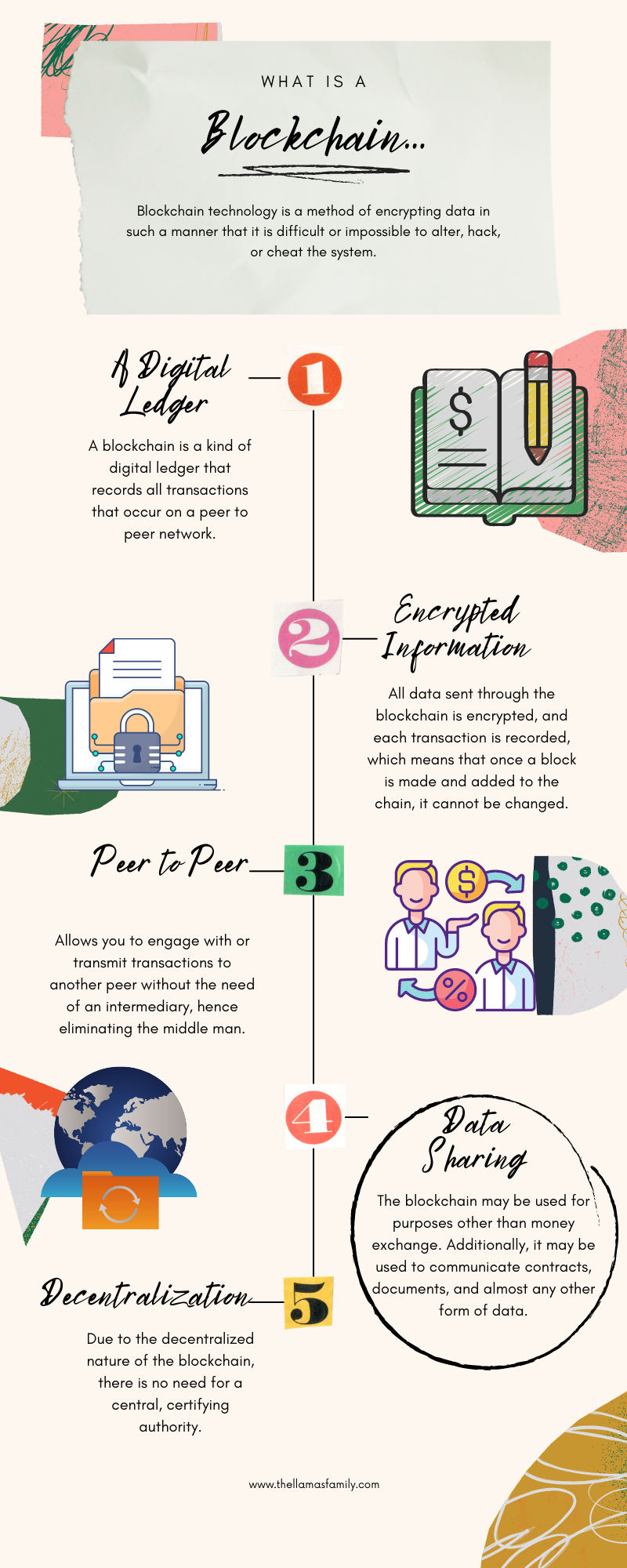
Blockchain technology, founded in 2008 by Satoshi Nakamoto, is a revolutionary technology development that has the potential of playing a crucial role in the ever-modernizing global economy. It is a decentralized and widely distributed database that serves as a repository for information called blocks, permanently saving data so that any involved block cannot be changed without affecting the succeeding blocks. It is a transparent digital ledger allowing full-time access and full disclosure about transactions preserving the integrity of the information. Virtually anything of value can be tracked and traded on a blockchain network, lowering risk and costs for all parties involved. This tech development is fundamental because everything depends on information and records. Through blockchain, it is received and stored more efficiently, more accurately, transparently, and most importantly, it is very secure that it is nearly impossible to be hacked. The blockchain capabilities are mainly used in bitcoin or cryptocurrency; nonetheless, it is slowly being adopted by financial institutions, medical institutions, and logistics fields.
The top-notch design and capabilities of blockchain make it a very reliable digital data storage. It boasts high-end security to protect sensitive data, minimizing the risk of hackers infiltrating the system. It stores records that couldn't be altered due to end-to-end encryption. Aside from its exceptional security features, a business or supplier could make transactions directly without participation from third-party firms, thus giving its users convenience and comfort. It also offers greater efficiency with faster service than traditional data processing that involves papers where supplier error or inconsistency could happen. In addition to that, blockchain possesses its own proof of authenticity and authority to impose limits. It also means that the transactions can be independently reviewed and completed.
Blockchain Disadvantage
However, no matter how advanced technology is, having its own disadvantages are inevitable for both businesses and customers alike. One of these downsides is its cost. A business that adopts this kind of technology could cost a user millions of dollars since various resources such as hiring a team of blockchain experts are needed to maintain this system with the additional costs of planning and licensing. Hence, blockchain has exclusivity. The most notorious problem with this is the non-scalability of the system. The more users enter the network, the network's response becomes slower; however, some methods are available to address this, namely using permissioned networks or using other blockchain solutions. Another solution is that transactions should be made outside the network, and only the said transaction records should be encoded in the digital ledger. Blockchain network has a handful of disadvantages, yet, its advantages still weigh the negatives. Its limitations mean that there is still room for development and betterment, and it shouldn't be treated as a significant setback.
What is the Relationship Between the Global Supply Chain & Blockchain?
Large corporations, such as Walmart, Baidu, and Boeing, use blockchain network in their supply chain. Other companies may implement the blockchain network in their businesses but will not follow through after its pilot implementation. Yet, despite its growing popularity and potential benefits, many companies and suppliers are not using blockchain applications in their supply chain models. The institutions that participate in the global supply chain are multinational companies, which means that these companies have branches and divisions located in many parts of the world. Due to the comprehensive coverage of a multinational company, it is difficult for a business or supplier to oversee any transactions made, and there is also the issue of information disclosure.
Having such a vast expanse of an area of operation, an institution requires a system that enables the headquarters to monitor and supervise the long and tedious process of production up until the distribution of products to the customers to prevent any losses and failures. The supply chain involves people, physical resources, information, processes, materials, and financial contracts and transactions, these diversified entities present are prone to developing errors along the journey of the transaction, and this is where the goal of the blockchain system lies. It allows for eliminating any human errors for smoother and hassle-free transactions. Transparency lets the customer see and trace the finished product information details. As such, transparency creates trust between the supply chain parties.
What are the Advantages and Disadvantages of Blockchain technology in the Global Supply Chain?
In the global supply chain industry, possessing a blockchain is a necessity. It allows for easy management by the institutions, and it also could help increase efficiency in the supply chain. This system helps in time efficiency by lessening paperwork, consistent with fast data encoding and tracing. The significant contribution that blockchain could present is its transparency; this alone could help develop the global supply chain. Showing accurate and tamper-free data improves accountability. An individual could see the product information instantly without any inconvenience. Furthermore, it will gain the trust of its customers due to the preservation of the integrity of its product information.
While employing a blockchain network in a global supply chain business strategy has its advantages, the technology is relatively new. The blockchain has some issues that the users may encounter, one of which is slow in encrypting information, especially when plenty of users log on to the system creating traffic that will slow the system's response time. In addition, it requires a huge data space, about 105 Gbytes for Bitcoin and 70 Gbytes for Bitcoin and Ethereum. The valuable assets of blockchain could also be a double-edged sword. Transparency could render harm to the privacy of information in place of the fact that anyone could access it anytime.
Moreover, its tamper-proof feature denotes that it is difficult to alter any encoding errors. As much as it claims to be seamlessly accurate, there is no guarantee that it is. There are also problems of smart contracts being buggy, a famous case of this was on Ethereum last 2016, wherein these smart contracts self-destructed, resulting in a massive loss of about $60 million. The issue occurred because smart contract bugs require a robust classification methodology.
What is Supply Chain Management?
Supply chain management (SCM) is the process of planning, implementing, and controlling the operations of a company. It includes the movement of supply and storage of raw materials, work-in-process inventory, and finished goods from warehouses point of origin to point of consumption. Supply chain management also involves coordination and collaboration with channel partners, which can be suppliers, intermediaries, third-party service providers, and customers.
In the supply chain management, there is a supply chain manager. The role of the manager is to optimize the entire supply chain process to ensure that it is as efficient and cost-effective as possible. The manager is responsible for planning, implementing, and controlling all aspects of the supply chain, including strategy, sourcing materials, production, storing finished product in warehouses, manufacturing, logistics, and distribution.
In the supply chain management, there is a supply chain manager. The role of the manager is to optimize the entire supply chain process to ensure that it is as efficient and cost-effective as possible. The manager is responsible for planning, implementing, and controlling all aspects of the supply chain, including strategy, sourcing materials, production, storing finished product in warehouses, manufacturing, logistics, and distribution.
What Are The Supply Chain Management Process Steps?
- Planning and Design: The first step in supply chain management is to plan and design the Supply Chain. This includes identifying the Supply Chain objectives, developing the Supply Chain Strategy, and designing the Supply Chain network.
- Sourcing: The next step is to source the materials and components needed to produce the products or services to meet customer demand. This includes supplier selection, contract negotiation, and supplier management.
- Manufacturing: The next step is to produce the products or services that the supplier will put to market for their customer. This includes managing the production process, quality control, and inventory management.
- logistics: The next step is to deliver the products or services to the customer. This includes transportation management, warehousing, and order fulfillment.
- Distribution: The final step is to distribute the products or services to the customer. This includes channel management, customer service, after-sales support, and making sure there is enough supply.
Supply Chain Management is a critical function for any company that wants to be successful in today’s marketplace. An efficient and effective Supply Chain Management strategy can provide a competitive advantage and create value for the customer.
Why is Supply Chain Management Critical?
The goal of Supply Chain Management is to create value for the customer by meeting supply demand, providing a seamless end-to-end experience to the market. Supply chain management is a strategic process that encompasses the entire value chain from the raw materials stage all the way to the end customer in the market. Supply Chain Management is a critical function for any company that wants to be successful in today’s marketplace. An efficient and effective Supply Chain Management process can provide a competitive advantage and create value for the customer.
The Importance of Logistics
Logistics is one of the most important parts in the supply chain management field. Logistics management is the process of planning, implementing, and controlling the operations of a company. It includes the movement and storage of raw materials, work-in-process inventory, and finished goods from point of origin to point of consumption. Supply chain management also involves coordination and collaboration with channel partners, which can be suppliers, intermediaries, third-party service providers, and customers.
Logistics is a critical part of the supply chain because it is responsible for the movement of goods from point A to point B. Logistics management is the process of planning, implementing, and controlling the transportation and storage of goods. It includes the movement and storage of raw materials, work-in-process inventory, and finished goods from point of origin to point of consumption. The goal of logistics is to ensure that the right products are delivered to the right place at the right time. Logistics management is a critical in the value chain.
Using Logistics services helps the company to be more efficient and effective in their business. For example, a company may use a logistics service to ship their products from one location to another. This can help the company save time and operating costs by not having to do it themselves, which brings. A logistics supplier can also help companies keep track of their inventory and shipments, which is good as they are following good business practices. This information can be used to make better decisions about production, marketing, and selling strategies to reach their customer.
Blockchain Logistics Network
A blockchain logistics network is a digital platform that uses blockchain components to track and manage the movement of goods throughout the supply chain. Blockchain is a distributed database that allows for transparent and secure sharing of information between parties, such as a supplier and distributor. The use of blockchain in the supply chain can help to improve transparency, accountability, and traceability of supply throughout the supply chain.
The blockchain network platform provides a single source of truth for all parties involved in the supply chain. The platform enables real-time tracking of goods and allows for traceability of supply from end to end. The blockchain network can be used by companies of all sizes to improve their supply chain management process. This is essential, especially with the introduction of digital transformation and Industry 4.0.
What is Digital Transformation?
Digital Transformation, and other new technologies, such as Industry 4.0, are changing the way that companies handle their supply. Digital Transformation is the process of using digital technologies to create new or improved business processes, products, and services. Industry 4.0 is the fourth industrial revolution and it is characterized by the use of digital technologies in manufacturing and other industrial sectors in multiple markets.
Digital Transformation is resulting in changes to the way that businesses operate. It is changing the way that businesses interact with their customers, suppliers, and employees. Digital Transformation is also resulting in changes to the way that products are designed, manufactured, and distributed. For example, companies that use digital transformation want to reduce cots and development their business strategy, all while tending to customer needs.
What is Industry 4.0 Technologies?
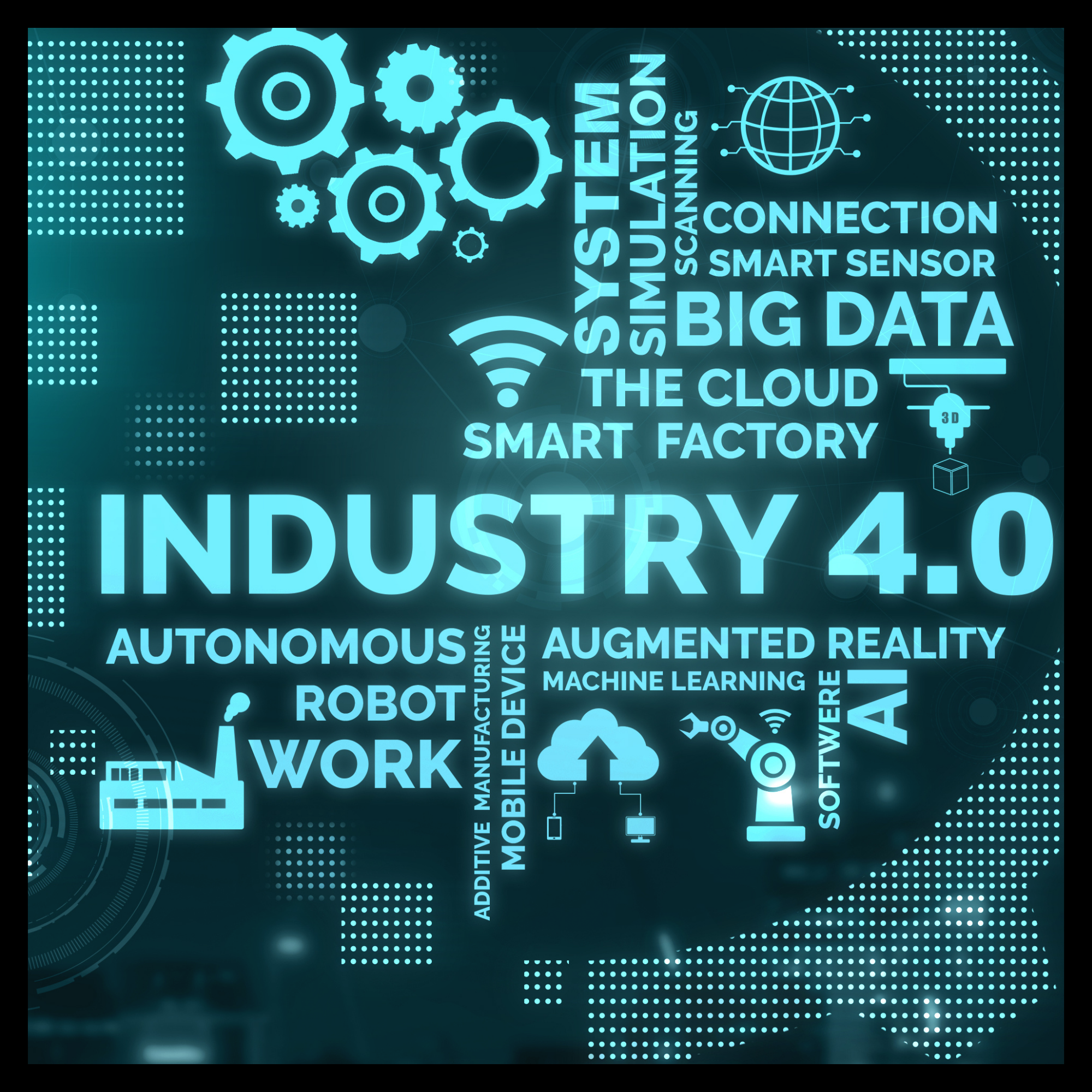
Industry 4.0 technology is a term that is used to describe the fourth industrial revolution. This revolution is being driven by the use of digital technologies in manufacturing and other industrial sectors in multiple markets. Industry 4.0 companies are changing the way that businesses operate and it is having a significant impact on the way that products are designed, manufactured, and operate.
In this new era of tech services, businesses are employing new management, supply and logistic strategies to enhance their capabilities in production to have a strong advantage over their competitors. Businesses are now able to manage their inventory and supply chain in a more efficient way using digital tools such as big data analytics and the internet of things. In addition, businesses are able to produce customized products at a lower cost than ever before.
How is Blockchain used in the Food Supply Chain?
In 2011, then-President Barack Obama signed the Food Safety Modernization Act, or FMSA, into law. Part of the FSMA requires organizations in the food supply chain to provide where the food came from and to who it was sold. In order words, food supply chain companies need traceability applications. A blockchain network safeguards quality control in handling food items. It helps track the processes the foods are undertaking, thus ensuring strict monitoring to prevent any damaging occurrence. The World Health Organization (WHO) estimated that one in 10 people frequently gets sick from consuming contaminated foods. Since blockchain, with the help of its information and records transparency, could show where the point of possible contamination site occur in the supply chain.
In addition, Blockchain components have the capabilities of improving the agricultural industry. This tech support could trace all the steps of the supplier before the product is displayed on the grocery shelves. Without going through any supplier intermediaries, the farmers and retail agricultural companies could do transactions directly, thus cutting costs and building trust and good relationships. Blockchain will provide farmers with justified and direct payments. Consumers and retailers alike will be able to access procedural information regarding the goods. It will give the farmers reasonable payments because it will show that strict quality control is being followed. An Australian agricultural company having a vision of making agricultural transactions digital implemented the usage of blockchain by selling 23.46 tons of grain in December 2016, making it the world's first settlement sale of agricultural products. Subsequently, plenty of transactions like this has transpired in the blockchain.
How is Blockchain Technology Used in Health Care?
Blockchain networks have great potential in enhancing the current healthcare system and workflow. During the COVID-19 pandemic peak, the whole world struggled to contain the virus, and there was no organized system dedicated to handling and controlling the situation . Citizens were at risk because the government and healthcare workers were having difficulties identifying and tracing suspected carriers of the disease, thus leading to further transmission of Covid-19. Blockchain components enables accurate and reliable data sharing while simultaneously protecting patients' right to privacy. The sharing of data could make a huge difference during a pandemic because it aids authorities in effectively identifying and tracking the infected individuals quickly, resulting in successful control of the situation.
What Are The Polices and Regulations of Blockchain?

Blockchain is decentralized and immutable. One of the features of blockchain capabilities are that all of the nodes in the network have a copy of the ledger, and any changes to it are reflected across the entire network. However, there are concerns about setting blockchain technological standards, policies, and government intervention. There is also a concern about barriers that could cause the adoption of the application to be slow. For example, policymakers may need to revise or amend certain frameworks to recognize and authorize international transactions in the global supply chain. It could require cross-border cooperation and a clear understanding of the technology by all parties involved (Fu et al., 2021).
In addition, decentralized blockchain capabilities raises concerns for regulators, governments, and policymakers. For example, China and South Korea banned an initial coin offering for the cryptocurrency called Centra. Furthermore, while beneficial, smart contracts could cause harm because any U.S. regulations do not cover smart contracts. Hence, party members could argue that one party could deliberately violate the agreement without legal repercussions.
What Functions Does Blockchain Enhance in Global Supply Chain?
Blockchain is an open-source system of records and information that is publicly accessible. This decentralized network of information means that not only one individual has the right to its access, but many people could use and encode information in the system. Moreover, the blockchain services are immutable. In other words, the technology has blocks connected through a "chain" of blocks; thus, once the blocks have been encrypted, it is nearly impossible to alternate them. Public access does not necessarily mean there is no privacy for the members and their transactions. Confidentiality is imperative in maintaining security for the members. In addition, blockchain services allows for smart contracting, a digital contract that is automatically executed when terms and agreements are met.
Blockchain is also helping in the supply chain management portion of the global supply chain. Supply chain management involves supervising the distribution and flow of goods, which includes the overall process of manufacturing up to its final product. This division is very crucial, no matter the industry. Supply chain management should be able to adapt to any situation to conserve the flow of goods. Disruption in the supply chains can consequently lead to economic losses. The concept of traditional supply chain systems should be examined and changed as it cannot meet the market's modernizing and growing demands. A contemporary adaptation of blockchain capabilities in the supply chain ushers it into a new era wherein transparency, versatility, and accuracy are present. Implementing blockchain components and an improved transaction process will permit faster and more cost-effective product transportation, better product traceability, and supplier cooperation.
In addition, blockchain services can create something called "smart contracts." Smart contracts are digital contracts. Like a traditional contract, it contains terms and conditions that need to be agreed upon by the parties involved. However, in smart contracts, the participating bodies should settle the terms to execute the conditions automatically. This system is part of the blockchain capabilities in charge of facilitating, verifying, and releasing funds. This platform could be imperative in industries related to logistics, supply, management, financial services, etc.
What Is Resource-based Theory?
Resource-based theory suggests that for an organization to have long-term success, it should possess unique resources that are impossible to copy and transform that distinctive asset into the company's strength, thereby achieving comparative advantage. The resource-based theory is needed to sustain leverage against competitors, providing organization leverage. It should be valuable enough that an institution will be able to capitalize on it. The resource should be impossible to copy or acquire by others and should be protected by trademark or patent. When referring to prized resources, it should not be limited to objects; it could be human resources, environment, financial and institutional resources, and when combined, can become a competitive advantage.
Organizations can use resource-based theory by methodically constructing, integrating, and restructuring the unique asset into the institutions' operations and work. The valuable resource pointed out could either be tangible or intangible. It could be both, as long as it is something that only the company possesses that converts into something used to capitalize. To know if the resource utilization is productive, it should be cost-effective. Another thing that denotes proper usage is quality compliance, which means the organization observed standard protocols. Lastly, there should be flexibility and innovativeness to compete with the emerging markets since these two aspects allow variation and resilience.
How Does Resource-based Theory work with Circular Economy?
Organizations that use resource-based theory also integrate the circular economy. The main aim of a circular economy is to boost the economy while preserving the environment. The organization should use all of the resources taken to the fullest and not waste any. After using the resources, the organization can recycle them and use them again for another commodity. The design of this concept is based on preserving nature, maximizing the usage of materials, eradicating or minimizing wastes. In addition, Hussain and Malik believe that a circular economy should be adopted by supply chains and used with supply chain linkages, such as blockchain because it will give supply chains more resilience.
Supply chain organizations that use blockchain support with circular environment systems create an efficient supply chain that can respond better to market changes and build competitiveness. Moreover, organizations that implement blockchain circular environment systems into their supply chain have capabilities specific to the company, which makes it harder to duplicate. In addition, the strategy can help firms recover quickly during a disruption in their supply chain. For example, during the Covid-19 pandemic, the global supply chain was heavily disrupted. The global supply chain encountered numerous problems during the pandemic, such as a shortage of supply, especially medical supply because the demands all over the world soared.
To achieve a more sustainable supply chain, it would need support. A way to maintain and preserve the flow of the supply, especially during a pandemic, is through the government's financial support to be able to mobilize the operation of companies. During the pandemic, numerous business establishments had filed for closure due to bankruptcy, and the role of the government here is to help these establishments continue their business to help maintain the flow of the supply. Another approach would be to develop strict policies that entail long-term effectiveness. By providing a strict policy, an organization can adapt quickly to a supply disruption if a government needs to have a lockdown during a pandemic. The organization can achieve this by being more socially and environmentally responsible because they significantly impact these areas. Hence, implementing blockchain-enabled circular economy systems.
Typological Theory and Blockchain
The typological theory allows theorists to identify connections of mechanisms and provide a way that the connections can produce effective results. The typological theory is helpful in young fields of research. Many researchers use typological theory to find blockchain-based applications besides cryptocurrencies. These applications include smart contracts and recordkeeping. However, Elsden et al. focused on developing a typology for blockchain applications from a business perspective. The research team developed a typology of seven classes of blockchain applications. One of the applications is "Proof-as-a-service," which includes notaries, registers and attestations, and supply chain management.
Adopting blockchain into the global supply chain, an organization can have multiple benefits. For example, blockchain provides tokenization, which allows exchanging sensitive data for non-sensitive data called a "token". It is beneficial for organizations because it provides faster transactions, enhances transparency, and increases accessibility and liquidity of supply. Moreover, traceability is the biggest concern and most important part of the global supply chain. Using blockchain support for the global supply chain is perfect for improving traceability.
How Does Institutional Theory Help in The Global Supply Chain?
Institutional theory suggests that organizations are pressured to adopt policies, practices, and processes deemed appropriate and consistent with their environment. There are three types of pressures that influence an organization's behavior. The first is coercive pressure indicated by stakeholders, such as government organizations, customers, and suppliers. The second is normative pressure initiated through expectations, such as values, norms, and the company's culture. The third is mimetic pressure caused by the uncertainty that the company may face.
The global supply chain industry is no exception to this theory. Institutional theory can examine how the global supply chain responds to external pressures. For example, supply chain managers can use the theory to understand how to manage the spaces, resources, legitimacy, and logistics to overcome external pressures. One way supply chain managers have overcome institutional pressures is by using innovative approaches, such as blockchain services for their supply.
An essential application of blockchain services requires no intermediaries in doing business transactions for their supply. This feature of blockchain is beneficial to the global supply chain because it can help reduce friction in the flow of supply and services. The elimination of intermediaries also allows for an increase in trust between the parties involved in a transaction. In addition, supply chain organizations can use blockchain services to create a more transparent system by providing a permanent record of all transactions of supply. This feature is important in the global supply chain because it can help to reduce fraudulent activities and improve efficiency.
Blockchain, with its features, attracts organizations into adopting its technology as there are benefits that it entails, such as convenience, security, and productivity. Government regulations also play a role in this; however, most governments worldwide do not support its technology due to cryptocurrency's association with illegal transactions. The benefits of blockchain technology have compelled many organizations to adopt and experiment with the technology. It is an excellent opportunity to improve traceability of supply, transparency, security, and frictions for the global supply chain.
What Factors Affect the Usage of Blockchain Services?
A central issue surrounding the adoption of blockchain services in the global supply chain is coercive pressure from uncertainty in government regulations. However, a study conducted by Hartley et al. found that global supply chain organizations are more inclined to adopt blockchain services with government regulation. The regulations are regarding product origin, are using updated cloud-based information systems, and face normative pressures. The government regulations that have been causing supply chain organizations to adopt blockchain services include, but are not limited to, customs clearance, conflict minerals, and the U.S. Drug Supply chain Security Act.
In addition, the global supply chain faces other non-technical challenges in implementing blockchain services. For example, most supply chain leaders are hesitant to invest in blockchain because of the lack of industry standards and practices. As such, organizations that have yet to adopt the blockchain services will not have existing support systems to help with the transition. Furthermore, entering the data in the correct order is an issue. For example, it must be accurate when data is entered into the blockchain because modifying the recorded information is not an easy task. Thus, it could be argued that while blockchain is immutable, it does not guarantee quality.
Lastly, scalability and interoperability are other factors affecting the usage of blockchain in businesses. For blockchain technology to be helpful on a global scale, it must be able to accommodate a large number of transactions. However, this is not always the case, as some blockchain platforms have experienced problems with scalability. In addition, for different blockchain platforms to work together, they must be interoperable. Interoperability means that they must be able to communicate and share data with each other. Unfortunately, this is not always the case, as different blockchain platforms use different protocols, making interoperability a challenge.
What is Private and Public Blockchain?

As stated before, blockchain is often described as a distributed ledger technology (DLT). A blockchain is essentially a digital record of transactions. The blockchain is distributed because it exists on multiple computers or nodes at the same time. This makes it difficult to tamper with because you would need to change the transaction history on all the computers or nodes at the same time, which is nearly impossible.
There are two main types of blockchain: public and private. A public blockchain is a blockchain that anyone can join and participate in. Bitcoin and Ethereum are examples of public blockchain. A private blockchain is a blockchain that is permissioned, meaning that only certain people or organizations can join and participate in the blockchain. Private blockchain is often used by organizations that want to use blockchain services but do not want to make their data public, such as businesses who have supply.
What are the Difference Between Public and Private Blockchains?
Another key difference between public and private blockchain is who can access the data. In a public blockchain, anyone can view the data. In a private blockchain, only certain people or organizations can view the data, such as businesses who need to track their rare product. Lastly, a key difference between public and private blockchain is how consensus is reached. In a public blockchain, consensus is reached through mining. In a private blockchain, consensus is reached through other means, such as voting.
Global Supply Chain Cost Effective Strategies
Global supply chain companies have to find ways to gain an advantage over their competitors. Supply chain companies have multiple strategies that they use to take raw material and send finished product to the end user. Also, supply chain services need to develop cost effective strategies to ensure finished products flow uninterrupted through their industry. For example, suppliers of electric vehicles need to create cost effective strategies when it comes to mining and sourcing the cobalt raw materials used in batteries. The suppliers also have to find ways to cut costs in transportation while ensuring the quality of the supply is not compromised.
Understanding the right service for transportation is critical in cost effectiveness. A service that is reliable and has been in operation for a while will generally be more expensive. A new service or one that is less well known will often be cheaper but may not have the same reliability. A company also needs to decide if it is better to use an airfreight or ocean freight services. The main difference between the two is time and cost. Airfreight is generally more expensive but gets the product to the customer faster. Ocean freight is generally less expensive but takes longer to get the product to the customer.
Another key difference between public and private blockchain is who can access the data. In a public blockchain, anyone can view the data. In a private blockchain, only certain people or organizations can view the data, such as businesses who need to track their rare product. Lastly, a key difference between public and private blockchain is how consensus is reached. In a public blockchain, consensus is reached through mining. In a private blockchain, consensus is reached through other means, such as voting.
Inventory Management
Inventory loss is a major cause of high supply chain management expenses. Each item you misplace or lose due to spoilage or damage reduces your ability to fulfill orders or satisfy customer demand. As a result, maximizing inventory management should be one of your top priorities. You can use various methods to track and manage supply, such as barcodes, radio frequency identification tags (RFID), and sensors.
Barcodes are the most common type of inventory management system. They are affordable and easy to use. RFID tags are more expensive than barcodes, but they offer more features and benefits. RFID tags can store more information than barcodes and do not need to be in line of sight of the reader to be read. Sensors are the most expensive type of inventory management system, but they offer the most benefits. Sensors can track the location of supply, as well as the temperature, humidity, and light level.
By closely managing your inventory and keeping track of each supply item you store, you may dramatically cut those expenditures. Even better, you'll be able to discover tendencies that contribute to inventory loss or waste, allowing you to make required adjustments to your logistics
What is the Cost of Using Blockchain?
This article has touched on the costs of using blockchain and the strategy businesses use. but there are different costs depending on the kind of service you are providing to your end user. For example, if you are using blockchain to create a new product, the development costs will be higher than if you were using it to track an existing product. End users also need to consider the costs of integrating blockchain into their existing systems.
In addition, there are hidden costs to using blockchain that do not require funds, but rather time and effort. For example, network congestion can slow down transactions of supply, which can end up costing the end user time and money. Network congestion occurs when blockchain becomes overburdened with transactions, resulting in a backlog. This is a supply and demand issue — there are just too many transactions and insufficient miners to confirm them. Unconfirmed transactions are stored in a "mempool" (memory + pool), a type of waiting room, until they are picked up and processed.
The Issue of Network Congestion
Having network congestion can be difficult because it can have unintended consequences of increasing mining costs when demand exceeds supply. A once-competitive fee may be reduced dramatically when miners are allowed to execute just the transactions that are of more value to them. As a consequence, new transactions of supply with a higher charge are processed first, with the remainder waiting until overall fee rates stabilize.
There is also the issue with the transaction size. If a transaction is too large, it may need to be broken up into multiple smaller transactions, which can end up costing the end user more money. This could be a potential issue using blockchain in the supply chain because supply data can be voluminous.
What Are Some Unforeseen Costs?
In addition, end users need to consider the costs of running a node, which is a computer that helps to keep the blockchain network running. Nodes confirm transactions and relay them across the network so they can eventually be added to the blockchain. They also store a copy of the entire blockchain so they can verify incoming transactions against it. end users need to have a certain amount of cryptocurrency in order to run a node, which can end up costing a significant amount of money.
Despite the costs, blockchain provides a number of advantages that can help end users save money in the long run. For example, blockchain can help end users reduce the risk of fraud. In the supply chain, end users can use blockchain to track the provenance of goods, from their point of origin to their destination in logistics services. This could help end users avoid situations where they end up buying counterfeit goods. In addition, blockchain can help end users reduce the need for intermediaries.
What Is the Relationship Between Artificial Intelligence and Blockchain?
After discussing the operating costs of blockchain, let's examine how artificial intelligence (AI) and blockchain may function together in multiple industries, such as logistics services.
To begin, it is critical to realize that AI is the process of teaching computers to make their own judgments. This may be accomplished in a variety of ways, including but not limited to the following: rule-based systems, decision trees, genetic algorithms, artificial neural networks, and reinforcement learning.
Second, we must comprehend how blockchain works. Blockchain technology is a decentralized database that enables safe, transparent, and tamper-resistant transactions. Each transaction is recorded on a public ledger and is verified by network nodes. This verification method significantly complicates the process of committing fraud or tampering with data.
How Does AI and Blockchain Function in Tandem?
One technique to combine AI with blockchain is via the use of smart contracts. Smart contracts are computer programs that conduct transactions automatically when specific circumstances are satisfied. For instance, when supply products are delivered, a smart contract may be utilized to automatically disburse payments to the supplier.
Smart contracts have the ability to significantly cut the cost of conducting business by automating a range of different transactions. Additionally, smart contracts may assist limit the risk of fraud by verifying the legitimacy of data before to executing a transaction.
What is Distributed Ledger Technology?
Another approach for AI and blockchain to collaborate is through distributed ledger technology (DLT). A distributed ledger technology (DLT) database is a form of database that enables safe, transparent, and tamper-proof transactions. Each transaction is recorded on a public ledger and is verified by network nodes.
DLT provides a number of benefits that make it particularly well-suited for supply chain application for keeping track of their supply. For instance, DLT may assist decrease the risk of fraud by tracking the origin of supply. Additionally, DLT may help eliminate the need for middlemen by directly connecting buyers and suppliers.
Finally, AI and blockchain may be used in conjunction to assist end consumers in saving money. For instance, blockchain services may be used to trace the provenance of supply from their origin to their final destination. This may assist end users in avoiding instances in which they purchase counterfeit supply items. Additionally, blockchain services enables end users to eliminate the need for middlemen.
What Is the Three-Way Link Between Blockchain, Artificial Intelligence, and the Cloud?
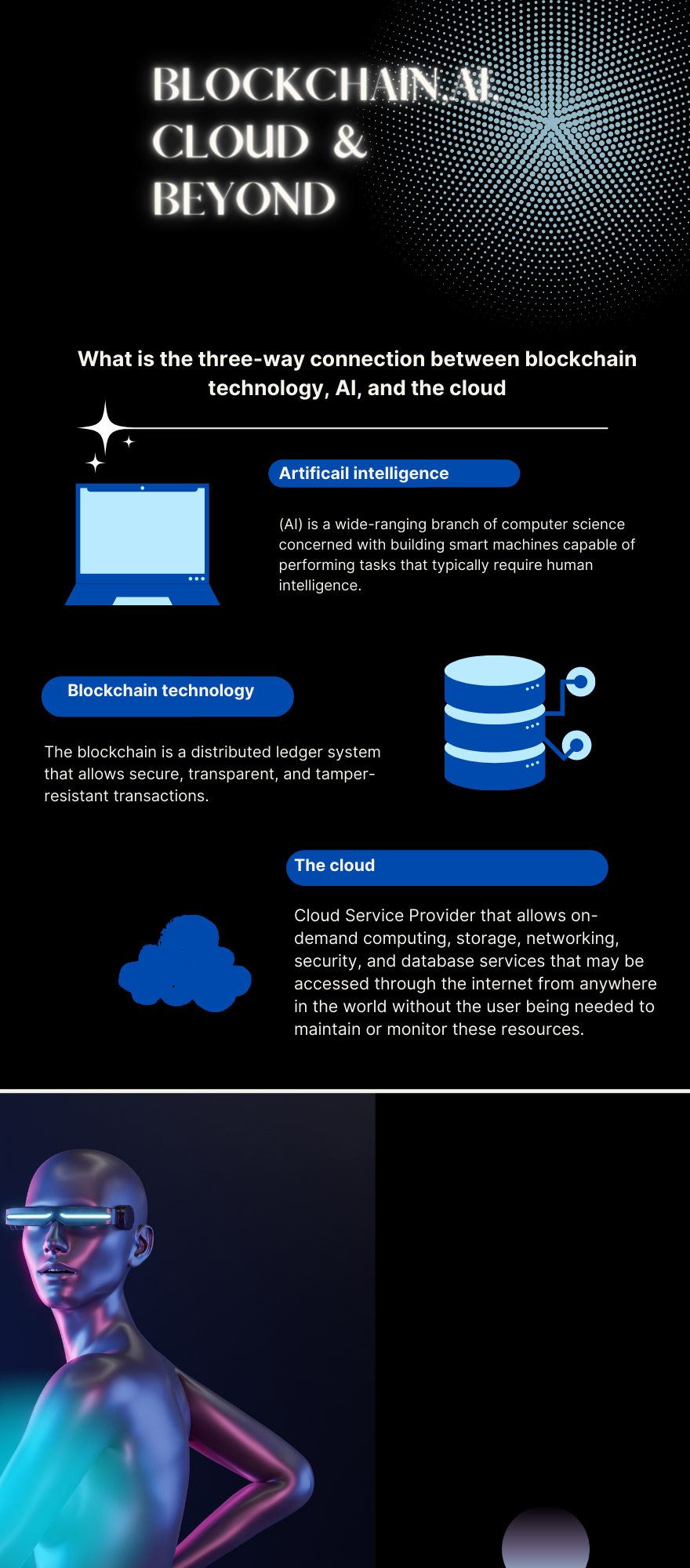
Improved demand management is a necessity that both blockchain and AI can address. For instance, if demand for a supply product suddenly surges, the price of the supply product may automatically increase to ensure that just the necessary amount is produced. Additionally, if the system has unused capacity, AI may aid in identifying and making it available to people in need.
The connection between blockchain and artificial intelligence becomes even more apparent when considering how these technologies may be used to govern resource access. For example, blockchain can support networks to track the origins of products, supply, and materials, and ensure that they are only available to authorized people. Additionally, AI may be used to monitor user activity and ensure that only authorized users have access to the system.
How is the Three-Part Sequence Connected?
The connection is structured around a three-part sequence of occurrences. Companies may use blockchain services to establish, maintain, and safeguard decentralized databases containing information about their supply transactions. Following that, AI is used to evaluate the data from the ledger in order to identify trends or patterns that may be utilized for a variety of reasons, including investing, monitoring, and trading. Finally, the cloud is utilized to store data generated by the ledger and AI algorithms, as well as to enable access to this data to any end user who requires it.
How Big Is the Blockchain Supply Chain Market?
The supply chain industry is a global industry that is always looking for ways to improve. The use of blockchain services has accelerated progress in the global supply chain sector.
While the application of blockchain strategy in supply chain management is still in its infancy, it offers immense potential for growth. In the supply chain business, blockchain is in high demand. Numerous firms may get access to and use blockchain into their business strategies. Businesses may form a support team to develop sturdy components that will help in their operation and concentrate on strategies to increase efficiency in their supply chain.
The blockchain market is enormous, and it is used in a wide variety of businesses in many industries. For instance, the banking industry is using blockchain to simplify its processes. They are able to accomplish so by combining data from many banks and shortening the time required to conduct transactions. This not only saves money for banks, but also improves the client experience.
Additionally, the retail sector is using blockchain to manage supply and avoid fraud. Businesses may ensure that they are receiving what they paid for by tracing the supply at each level of the supply chain. This also helps in the fight against counterfeit products.
Blockchain's potential is limitless, yet it is just now starting to be appreciated. The supply chain business is likely to expand even more with the assistance of artificial intelligence. The market will continue to rise as more businesses implement blockchain as a strategy.
Blockchain in Many Industries
As mentioned previously, blockchain is used in multiple industries. examples include the global supply chains, retail, military, and Web3. The markets for these industries are different, and the strategies used will be as well. In order to understand how to apply blockchain in each of these markets, one must first understand what each market entails.
Blockchain in the Web3 Industry
Web3 is a term used by some technologists to refer to the notion of a new kind of internet service based on decentralized blockchains — the distributed ledger technology used by cryptocurrencies such as Bitcoin and Ether.
Web3 proponents envision a range of applications, including decentralized social networks, "play-to-earn" video games that reward players with crypto tokens, and non-financial-transaction platforms that let users to buy and sell pieces of digital culture. The more positive view is that web3 will fundamentally transform the internet as we know it, upending traditional gatekeepers and ushering in a new, middleman-free digital economy.
The blockchain is a distributed ledger technology that enables the storage and movement of data without the need for a central authority. This enables data sharing without the involvement of third parties such as banks or government organizations, hence reducing time delays, transaction costs, and censorship threats. The Web3 sector is using blockchain to increase its market competitiveness.
MetaMask
The use of blockchain in the Web3 business is still in its infancy. However, a few projects are making use of this technology. The most notable project is MetaMask, which allows users to access decentralized applications (dapps) on the Ethereum blockchain. MetaMask enables safe connections to decentralized applications (dapps) without the need to operate a complete node or install any software.
uPort
uPort is another initiative that utilizes blockchain in the Web3 business. uPort is an identity management software that empowers individuals to take control of their data. uPort leverages blockchain to empower people with ownership of their data, which they can then use to connect into decentralized applications and websites. uPort is only one example of how blockchain might be used to the Web3. As the sector grows, we can anticipate seeing more projects that include this technology.
Military use of blockchain
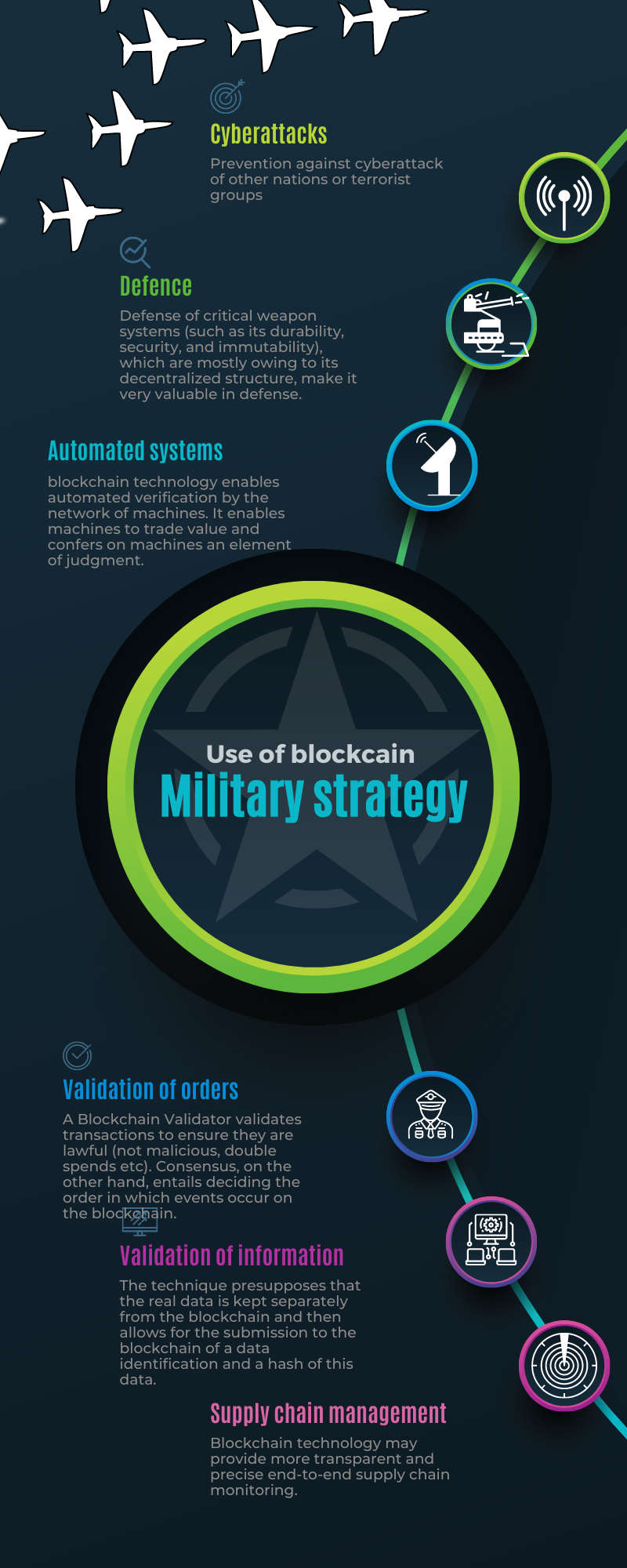
Demand for blockchain continues to grow. Blockchain has uses in a variety of sectors, one of which being the military. Within a military organization, blockchain may be utilized to enhance data access and network security. Additionally, it provides several additional benefits, such as the ability to lower transaction times and costs while enhancing data privacy. Additionally, blockchain may aid in the battle against corruption and battlefield supply of armory.
The military is a vast and complicated institution. It is made up of several distinct entities that operate in a variety of geographical places. This may make it more difficult for units to communicate information and data. By establishing a common database that can be accessible by all units, blockchain may be utilized to resolve this issue. This would enable units to have real-time access to the same data, supply, and information, hence improving communication and coordination.
The Advantages of Blockchain in Industries
One advantage that blockchain has the potential to resolve is data security. The military deals with highly confidential material that must be safeguarded. Because blockchain provides a high degree of security, it may be employed in military applications. A blockchain's data is encrypted and may be viewed only by authorized users. This makes hacking military data more difficult.
In addition, it has the ability to fundamentally alter the way the military operates. The usage of blockchain inside a military organization may increase data access, network security, supply procurement, and communication. Additionally, it has the ability to cut transaction times, costs, and corruption. Military is only one of the several businesses that might profit from blockchain adoption.
Blockchain on the Battlefield

On the battlefield, time delay is critical because it might mean the difference between life and death. When troops are engaged in combat, they must be able to communicate swiftly and effectively. This need precise and timely data. If communication is delayed, it might result in confusion and anarchy, which can result in fatalities.
Blockchain is a distributed ledger that may be used for a variety of purposes, from transaction recording to supply chain monitoring. Moreover, it can help to re-supply combatants on the battlefield faster by keeping track of armory supply products and other materials.
Blockchain enables faster data access on the battlefield, which is critical while people are fighting. When access times are excessively sluggish, it might cause misunderstanding and communication delays. By offering a shared database that can be accessed in real time by all units, blockchain may assist cut access time.
Another critical feature of blockchain is its high level of security. This is critical for the military, since it deals with highly classified material. A blockchain's data is encrypted and may be viewed only by authorized users. This makes hacking military data more difficult.
Finally, blockchain has the potential to significantly eliminate corruption. Corruption is a significant issue in the military, since it may result in waste, fraud, and power abuse. By offering a transparent and secure method of recording transactions, blockchain may help minimize corruption. This makes it more difficult for dishonest authorities to conceal or alter data.
Nonetheless, one of the most compelling applications of blockchain is its capacity to aid in the prevention of cyber-attacks. Due to the sensitive nature of its data, the military is a major target for cyber-attacks. If the military adopts blockchain, hackers will have a considerably more difficult time gaining access to its data. This is because the data on a blockchain is encrypted and distributed over a computer network.
Blockchain and big data
Two of the most disruptive technologies to emerge in recent years are blockchain and big data. Although these two technologies are often mentioned in the same breath, there is still some uncertainty regarding how these two technologies may be employed in conjunction.
As data is created at an increasing pace, organizations are finding it more difficult to make sense of it all. The term "big data" refers to a significant amount of data that is too difficult to analyze using conventional techniques. Often unstructured, this data is available in a number of forms, including text, photos, and video.
Blockchain can be utilized to securely and efficiently store this massive amount of data. Due to the distributed structure of blockchain, it is very impossible to tamper with data. As a result, it is a great platform for storing sensitive data, such as medical records and financial data.
Big Data and Smart Contracts

Another option to combine blockchain and big data is via the creation of smart contracts. A smart contract is a self-executing agreement between two parties that includes the conditions of the agreement. These contracts are decentralized and may be used to automate a wide range of functions.
For instance, it may be used to automatically disburse cash upon the completion of a delivery. This would minimize the need for manual processing and improve the efficiency of the operation.
Big Data and Accuracy
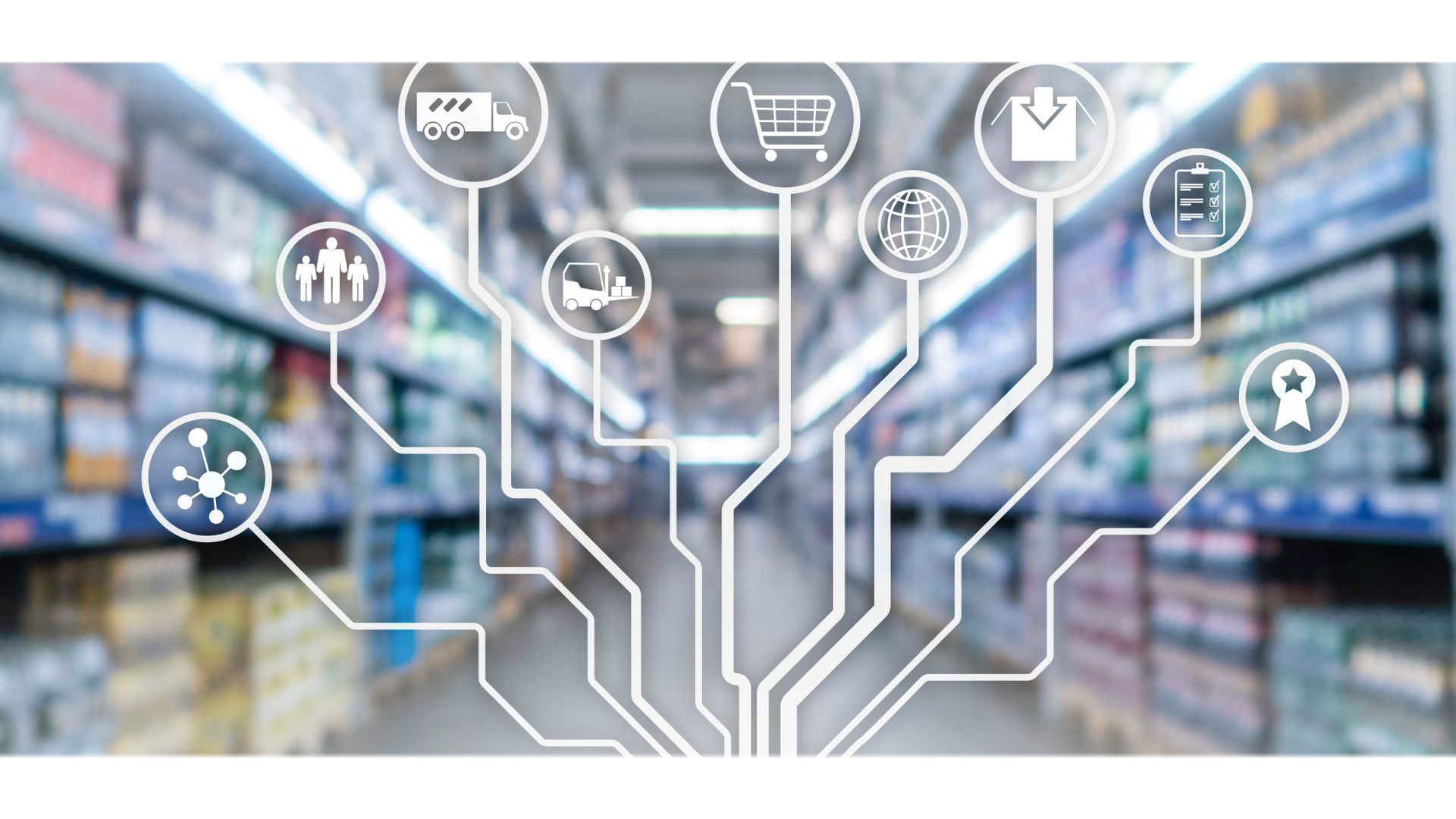
Additionally, big data may be utilized to validate the accuracy of data recorded on the blockchain. This is feasible because big data enables the tracking of patterns and trends. If there is a difference between the data on the blockchain and the data in the actual world, the data on the blockchain has very certainly been tampered with.
Often referred to as the "internet of value," the combination of blockchain and big data is referred to as the "internet of value." This is because blockchain enables the safe and efficient storage and transmission of data, while big data may be utilized to check the data's correctness. These technologies, when combined, have the potential to transform a wide range of sectors, from healthcare to banking.
What's Its Application in the Healthcare Industry?

Healthcare is believed to be difficult and complex due to radical advances in areas such as clinical trials and cloud computing use. By putting the patient at the center of the medical ecosystem, blockchain has the potential to eliminate difficulties and transform healthcare. Firms are experimenting with blockchain applications in healthcare, and with excellent monitoring of payment option upgrades and decentralization of patient data, Blockchain has firmly established itself as an indispensable tool.
The technique is renowned for its impermanence and security. The transaction will be recorded in the form of blocks, which will prevent it from being reworked or altered. The technology advances cryptographic approaches that enable the cybercity's data exchange structure. This enables seamless patient data management, and as the data is being recorded, cloud computing will be used to store it. Through the use of smart contracts, the patient will be able to simply control data access. Viant, a blockchain-based company, offers a solution for pharma majors' supply chains to eliminate the problem. Typically, the application is built on technology tracing and is aligned with the medical industry's supply chain. Thus, by integrating technology effectively, cooperation and monitoring may be strengthened while also saving time and effort. Big data analytics provides enhanced possibilities for assessing patient therapy, response patterns, and medication use. These findings aid in the provision of low-cost therapy and the development of tools for the benefit of the public.
What's Its Application in the Financial Industry
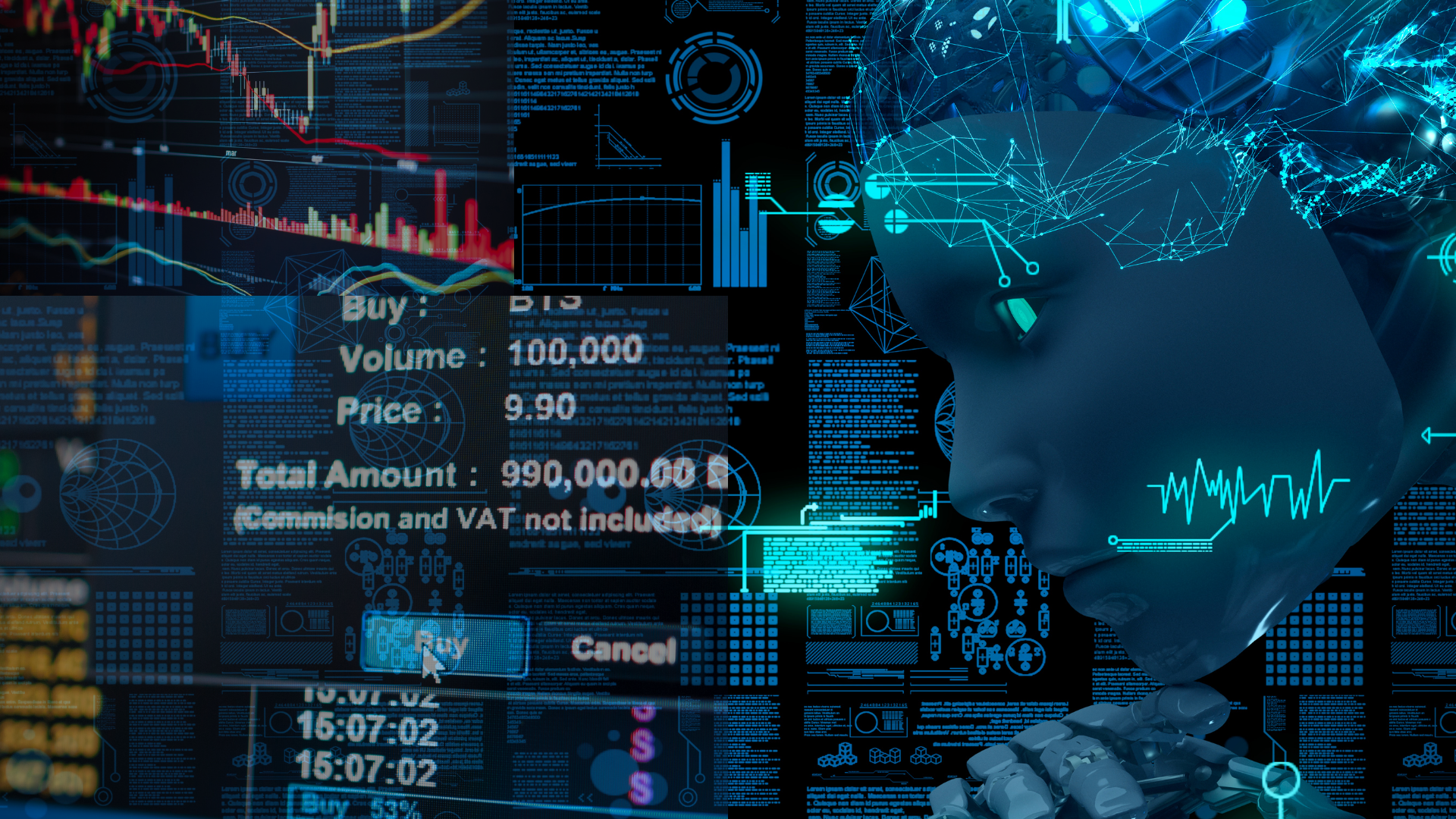
Blockchain is primarily concerned with automating the procedures necessary for achieving the requirements for adequate regulation prior to implementation. Within the financial business, there has been an increasing requirement for compliance, which highlights the importance of shifting toward securing emerging technology. All of these may be utilized to improve data storage, tracking, and retrieval. The volume, pace, and diversity of data on which the majority of financial institutions rely are discovered to be much more overwhelming. All of the game-changing innovations that have resulted from data may give unquestionable benefit. Utilizing some of the most cutting-edge technology in the financial sector, such as Big Data and Blockchain, may assist the banking industry in moving beyond the simple choice of cashless payment. Machine learning systems may assist in automating the process of learning and improving for the purpose of identifying potential dangers, hence facilitating a better understanding and avoidance.
The majority of financial firms place a premium on big data because it enables them to better understand operations such as trading, fraud, and risk. Fintech firms may assist in trading certain types of algorithms that can outperform rivals. Supervised machine learning may provide a greater degree of accuracy than any other mathematical model. This is due to the fact that trading choices are made based on stocks and models. Blockchain may assist in automating some types of operations, hence assisting in adhering to appropriate rules prior to execution. Within the financial business, there has been an increased need for compliance software that may assist in storing, tracking, and retrieving data. Blockchain does not provide a central point of weakness that must be exploited in order to make current technology secure and transparent. Both big data and machine learning may assist businesses in gaining a general understanding of their clients prior to analytics and forecasting. Additionally, data-driven insights may aid in data analysis and limit the possibility of human mistake.
The real-time deployment of big data and blockchain in the banking business has the potential to drastically cut service costs while simultaneously reducing risk. Money lending platforms mostly employ this strategy to assure the security, transparency, and reliability of the data supplied by users. When there is no risk involved, it can decide whether or not transactions are fair. Numerous these systems are established by significant financial institutions that are also capable of validating and analyzing payments.
What's Its Application in the Retail Industry
Blockchain may be used to limit the number of alternative scenarios that can be formed when a database is utilized. It will contribute to improving food safety, increasing profit, and reducing total waste. Blockchain and big data may aid with fraud protection, loyalty point management, customer data complaints, cryptocurrency payment acceptance, and inventory tracking. Blockchain was developed to thwart any fraudulent behavior involving the exchange of digital currencies. Several retail sector giants are using Blockchain to block certain goods from reaching their intended clients. Blockchain seeks to deliver real-time allocation and redemption to various consumer and loyalty program operators. By using smart contracts, blockchain may assist in managing data privacy for a variety of consumers. This technique may be used to the creation of cryptocurrencies, which can then be used to store value or data. This is particularly relevant for shops capable of processing cross-border payments and micro-payments. Blockchain may provide total insight to the supply chain and retailers at all points. This will assist them in accurately monitoring shipments for performing goods.
The Most Effective Methods for Learning About Blockchain Applications

Given the breadth of blockchain technology's possible uses, it might be difficult to know where to begin while learning about this burgeoning industry. There are, however, a few critical sites that may assist consumers and organizations in becoming acquainted with the fundamentals of blockchain applications.
Resources Available Online
One excellent strategy to get acquainted with blockchain applications is to peruse internet materials provided by prominent blockchain development companies. These organizations are often at the front edge of blockchain innovation and may give important insight into the technology's most cutting-edge uses. Additionally, many of these organizations provide online courses or other educational resources that may assist individuals in comprehending how blockchain works and the applications for which it can be employed.
Books To Be Read
Along with online resources, there are a variety of books that may assist individuals in learning about blockchain applications. For example, Arshdeep Bahga and Vijay Madisetti's book "Blockchain Applications: A Hands-On Approach" takes a comprehensive look at how blockchain technology might be used in a number of different scenarios. This book is suitable for anybody interested in gaining a firm grasp on the fundamentals of blockchain technology and its possible applications.
Another useful book is Andreas Antonopoulos' "Mastering Bitcoin: Programming the Open Blockchain." This book gives a technical explanation of how blockchain technology works and illustrates its potential via a variety of case studies. This book is best suited for those with a background in programming who want to understand more about the inner workings of blockchain.
Conferences and Other Special Events
Attending conferences and events devoted to blockchain applications is another excellent option to get knowledge about the technology. These conferences provide attendees the chance to hear from renowned experts in the area and see how blockchain technology is being used in a range of different contexts. Additionally, attendees may network with other professionals that have an interest in this subject, which can be beneficial for locating employment possibilities or business partners.
Community or Focus Group Discussions
Attending conferences and events is an excellent method to meet like-minded folks. As such, you may connect with members of a network of focus groups focused on blockchain technology and applications. These focus groups may be an excellent source of information regarding this subject and can also serve as a sounding board for fresh ideas.
Numerous online and offline organizations teach and educate about blockchain technology. These sessions are often led by industry experts who can aid beginners in grasping the principles of blockchain technology and how it works. Joining a community is a wonderful way to begin learning about blockchain technology, meet new people, and get knowledge from industry peers.
Podcasts

Another fantastic approach to learn about blockchain applications is to listen to podcasts. Podcasts are an easy way to consume knowledge on the fly, and there are a lot of excellent blockchain-related podcasts available. For example, the "Blockchain Insider" podcast offers interviews with prominent players in the blockchain sector and covers a broad variety of blockchain-related issues.
Summary
Blockchain technology is a relatively new field of study that is continually being explored. The advantages of blockchain technology include increased transparency, security, and efficiency. These advantages have prompted the adoption of the technology by a large number of global supply chain enterprises. Despite this, a number of obstacles must be overcome before the technology can be completely integrated into the global supply chain. These obstacles include regulatory ambiguity and a lack of knowledge of the technology.
The global supply chain business is not immune to institutional influences. To address these challenges, many supply chain managers are turning to blockchain technology to boost efficiency and transparency. Blockchain technology is a decentralized and secure system that is "trustless," in the sense that it does not need one party to trust another. This characteristic of blockchain technology benefits the global supply chain by reducing friction in the movement of products and services. Eliminating middlemen also enables a boost in confidence between the parties to a transaction. Additionally, an organization may employ blockchain technology to build a more transparent system by ensuring that all transactions are permanently recorded. This capability is critical in the global supply chain since it may aid in the reduction of fraudulent activity and increase efficiency.
Furthermore, the application of blockchain in various industries has proven to be a remarkable use case. The ultimate aim is to have a single source of truth that can be relied on by all parties in the network. In this way, blockchain has the potential to streamline the global supply chain and make it more efficient.
The benefits of blockchain technology are clear. However, there are still a few challenges that need to be addressed before the technology can be fully integrated into the global supply chain. These challenges include regulatory ambiguity and a lack of knowledge of the technology. Nevertheless, as more and more enterprises adopt blockchain technology, these challenges will likely be overcome. Consequently, we can expect to see blockchain play an increasingly important role in the global supply chain, and other various industries in the years to come.
FAQ
How does blockchain network help warehouse capabilities?
Blockchain services can help streamline and optimize warehouse capabilities in a number of ways. First and foremost, blockchain can help businesses keep track of inventory levels inventory management in real time. This is because each transaction that takes place on the blockchain is automatically logged and recorded. This information can then be used to generate up-to-the-minute reports on inventory levels and demand, which can be very helpful in managing stock levels. Furthermore, because blockchain is tamper-proof, businesses can be confident that the data they are looking at is accurate and reliable.
How does blockchain help business with supply and demand affect?
Blockchain development can help businesses in a number of ways when it comes to supply and demand. For example, blockchain can be used to create a decentralized marketplace where customers and sellers can connect to trade raw material or finished goods directly with each other. This could help to solve problems with regional monopolies, inflated higher prices, and lack of transparency in traditional markets. In addition, blockchain can be used to track provenance of goods throughout the supply chain. This would help businesses to ensure that they are only dealing with legitimate suppliers and that the products they are receiving are of the quality that they expect. Finally, blockchain-based smart contract could be used to automate supply and demand-related processes, such as ordering and payments. This would help to reduce the need for manual intervention and paperwork, which can often lead to errors and delays.
How does blockchain capabilities help business production and risk ?
Blockchain services has the potential to help business streamline production and reduce risk. By creating a decentralized, tamper-proof system for tracking data and transactions of customers, blockchain could help business simplify supply chain strategy, reduce admin costs, and increase transparency and accountability between suppliers and customer. Additionally, Many industries will see a lowering of cost with more services being available.
How does blockchain help companies with logistics?
Simply put, blockchain network provides a secure and efficient way for companies to track and manage their logistics operations. By using a distributed database that is constantly verified and updated by all participating parties, blockchain can help streamline supply chain strategy and ensure the accuracy of data. In addition, blockchain services can automate many of the processes involved in logistics an warehouse capabilities.
How Does Blockchain help with Raw Material?
Blockchain can help businesses track the provenance of raw materials throughout the supply chain. This would help businesses to ensure that they are only dealing with legitimate suppliers and that the products they are receiving are of the quality that they expect. In addition, blockchain-based smart contract could be used to automate ordering and payments, which would help to reduce the need for manual intervention and paperwork.
How Are Markets Using Blockchain?
Blockchain is being used in a number of different ways by businesses and organizations across a variety of industries. Here are some examples:
-In 2018, Walmart began working on a strategy with IBM to use blockchain to track the provenance of food items throughout the supply chain from farm to store shelves. This would help Walmart to ensure that the food it sells is safe and of the highest quality.
-In 2019, the shipping giant Maersk announced that it was launching a blockchain-based platform to track container shipments. The platform would help Maersk to improve the efficiency of its operations, reduce costs and minimize risk.
-The diamond company De Beers has been using blockchain to track diamonds throughout the supply chain since 2018. The company’s blockchain platform, Tracr, helps to ensure that there is enough supply for their customers that that the diamonds are conflict-free and of the highest quality.
How does blockchain network help with operating cost ?
Operating costs are typically associated with the day-to-day running of a business and can include everything from rent and salaries to electricity and insurance. By deploying a blockchain solution, businesses can streamline their operations and reduce their costs in a number of ways.
How Does Blockchain help with Production?
Many production companies are looking into blockchain as a way to streamline their supply chains and reduce costs. Here are some examples of how production companies are using blockchain:
-The German auto giant Daimler is using blockchain to track the provenance of materials from suppliers, such as cobalt used in the production of batteries for electric cars. The company’s blockchain platform, Cobalt Blockchain, is designed to help Daimler ensure that the cobalt it sources is conflict-free and of the highest quality.
-In 2018, BMW announced that it was piloting a blockchain-based system to track the provenance of minerals used in the production of car batteries. The system, called Mineral Blockchain, is designed to help BMW ensure that the materials that they get from suppliers are safe for production and that it meets the customer demand.
How Does Blockchain help Stock Markets?
The stock market is a complex and ever-changing ecology that is continuously adapting to its players' requirements. In recent years, there has been a greater emphasis on the use of technology to simplify and optimize processes. One area that has garnered much interest is the use of blockchain to assist in the management of the stock market.
While the stock market has been sluggish to accept blockchain technology, there are a number of potential benefits. For instance, blockchain may be used to automate the process of purchasing and selling equities. Currently, investors must go via a broker to purchase or sell stocks. This may be a lengthy and expensive procedure. The procedure might be streamlined and made more efficient using blockchain technology.
Does Amazon use blockchain?
Yes, Amazon uses blockchain as a part of its Amazon Managed Blockchain strategy. Amazon Managed Blockchain is a fully managed service that makes it easy to create and manage scalable blockchain networks using the popular open source frameworks Hyperledger Fabric and Ethereum.
Is blockchain used in cloud computing?
Yes, blockchain is used in cloud computing. A blockchain-based cloud storage system would be more secure and efficient than the current system. Cloud storage is a service that allows users to store data on remote servers. The data is then accessible from anywhere in the world. This is convenient for users who need to access their data from different devices. However, the current system is vulnerable to hacking and data loss. Blockchain-based cloud storage would be more secure because each file would be stored in a block that is chained to other blocks.
What is the use of blockchain in marketplaces?
Blockchain can be used in marketplaces to create a more efficient and secure marketplace. Marketplaces are platforms that allow buyers and sellers to connect and trade goods and services. Currently, marketplaces are vulnerable to fraud and scams. Blockchain-based marketplaces would be more secure because each transaction would be recorded in a block that is chained to other blocks. This would make it difficult for fraudsters to alter the data.